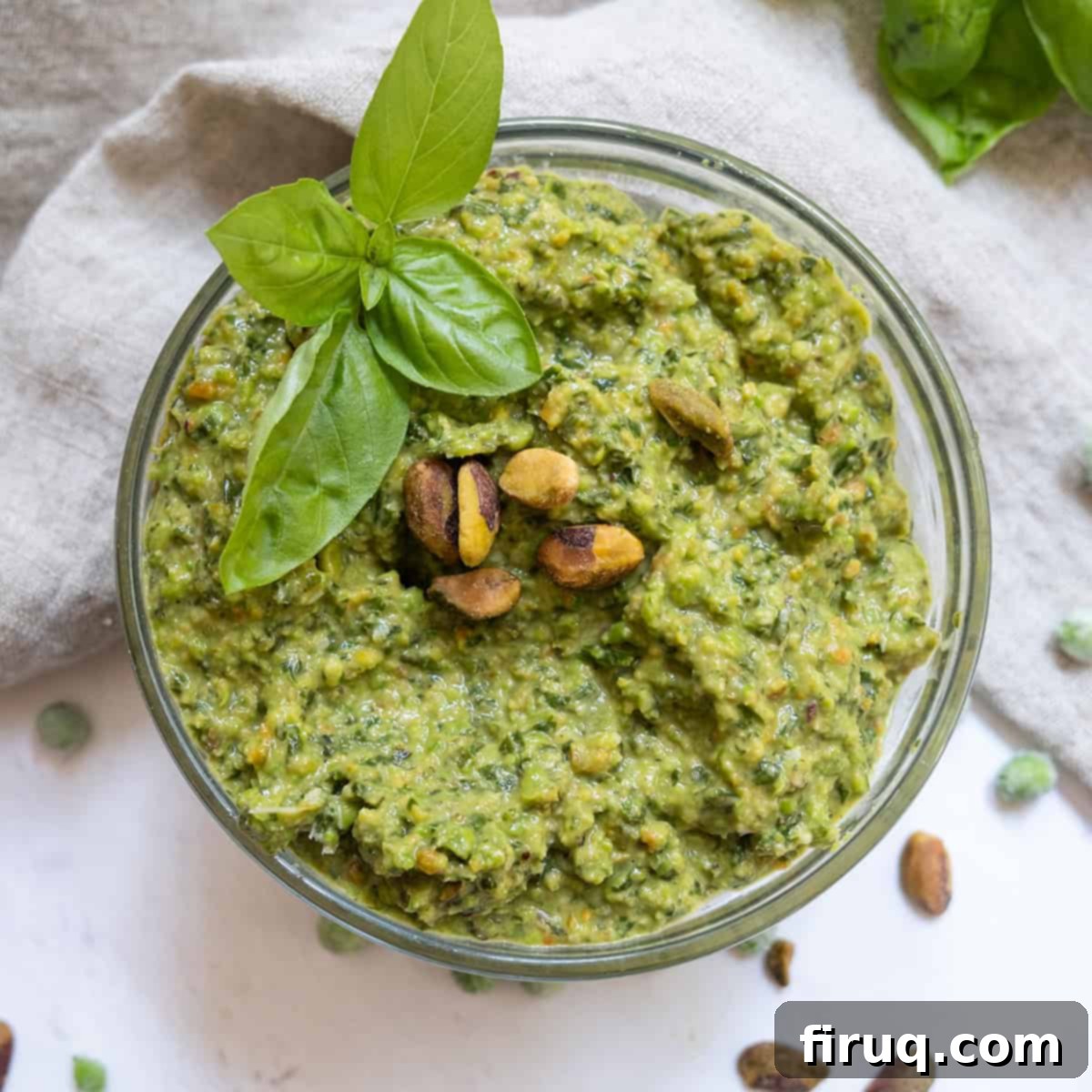The Ultimate Pea Pesto Recipe: Flavorful, Budget-Friendly, and Perfect Year-Round
Are you craving the vibrant, herbaceous flavor of pesto but find fresh basil hard to come by, or prohibitively expensive, especially during the colder months? Look no further! This incredible Pea Pesto recipe is your perfect solution. It’s a remarkably easy, affordable, and utterly delicious alternative that allows you to enjoy that delightful pesto goodness any time of year. Forget waiting for summer basil; this pea-based version delivers a rich, fresh taste that will surprise and delight your palate, making it a staple in your kitchen.
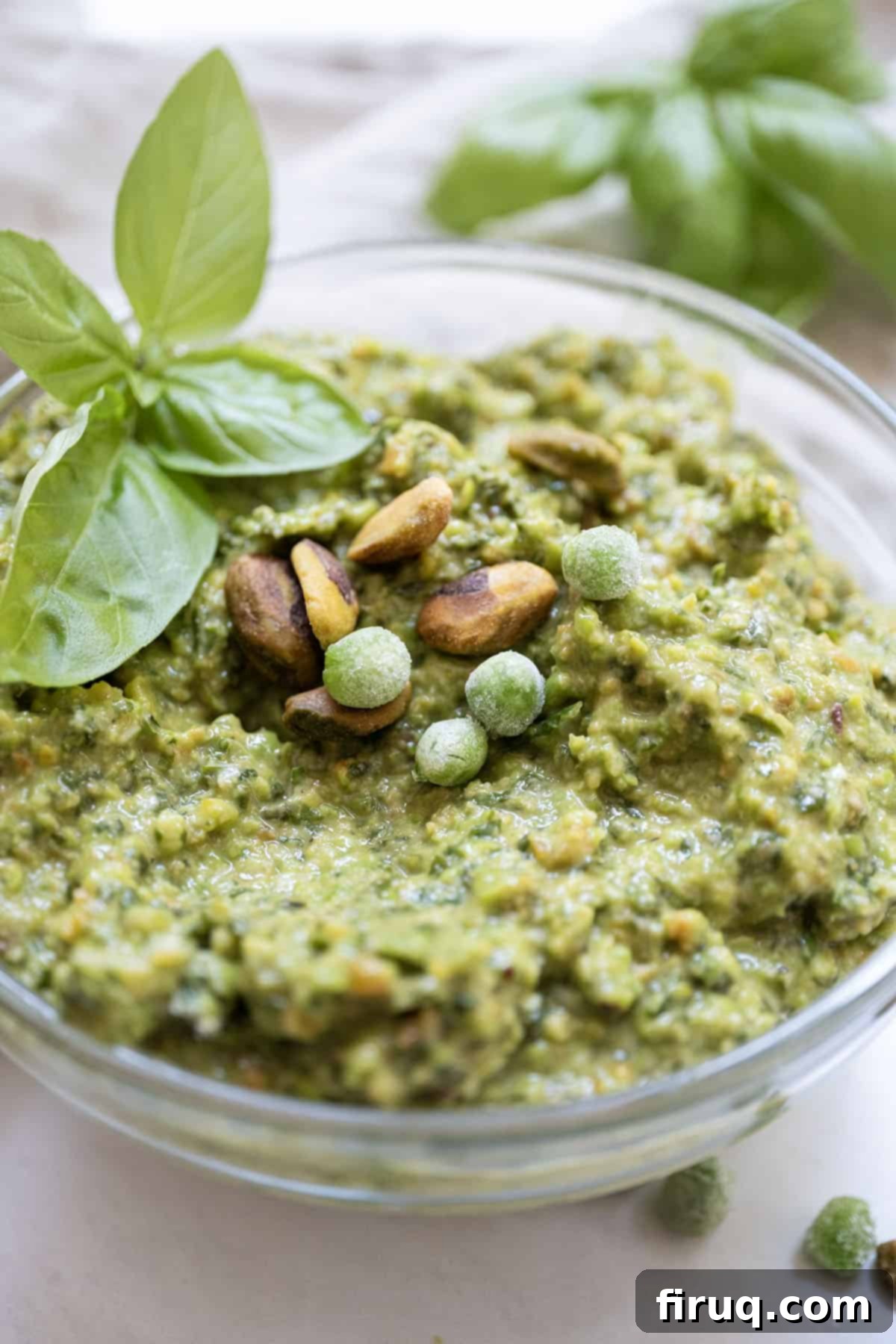
Wondering how to best enjoy this vibrant pea pesto? It’s incredibly versatile! Try incorporating it into our Pesto Stuffed Chicken for a delightful main course, or swirl it into a comforting bowl of Pasta with Peas and Pancetta for an extra layer of flavor. It also makes a fantastic spread for sandwiches or a delicious dip for crusty bread.
Why Pea Pesto is Your Go-To Affordable Alternative to Traditional Genovese Pesto
For many, pesto is a year-round craving, a burst of fresh flavor that elevates countless dishes. However, maintaining a steady supply of fresh basil, especially outside of peak growing season, can be a challenge. In winter, basil becomes notoriously expensive and often only available in small, underwhelming quantities at grocery stores. This is precisely why pea pesto is my favorite alternative to traditional basil pesto.
While I dream of a garden overflowing with basil year-round, that project is still on my to-do list! In the meantime, this brilliant recipe offers a pragmatic and equally delicious solution. It cleverly uses frozen peas as its main ingredient, providing bulk, sweetness, and a beautiful green hue. Imagine this: a large bag of frozen peas often costs just a dollar or two! This makes it incredibly easy and significantly more affordable than relying solely on pricey off-season basil. Of course, this recipe still incorporates a small handful of fresh basil to deliver that authentic, aromatic pesto essence, but it’s no longer the star ingredient. Instead, the peas provide the foundation, allowing that little bit of basil to go a long way.
Another smart swap in this pea pesto recipe is using pistachios instead of traditional pine nuts. While pistachios might be slightly more expensive than some other nuts, they are generally more affordable than pine nuts and offer a wonderfully rich, subtly sweet flavor and a creamy texture that blends beautifully into the pesto. This thoughtful ingredient choice further contributes to making this a truly budget-friendly pesto option.
Not only is pea pesto economical, but it’s also incredibly versatile. It can be substituted seamlessly in any recipe where you’d typically use pesto. Its vibrant flavor and creamy texture are perfect for topping a hearty sandwich like an Eggplant Caprese Grilled Cheese or tossed through your favorite pasta, such as Sausage and Fennel Pasta. It’s also a fantastic way to introduce more vegetables into your diet without sacrificing flavor. Plus, its excellent shelf life makes it ideal for meal prep: it stays fresh in the fridge for up to a week and can be frozen for up to 6 months, ensuring you always have a homemade burst of flavor on hand!
Essential Ingredient Notes and Smart Substitutions
Crafting the perfect pea pesto starts with understanding each ingredient and knowing when and how to make smart substitutions. Here’s a closer look at what you’ll need and how to customize it to your taste or dietary needs.
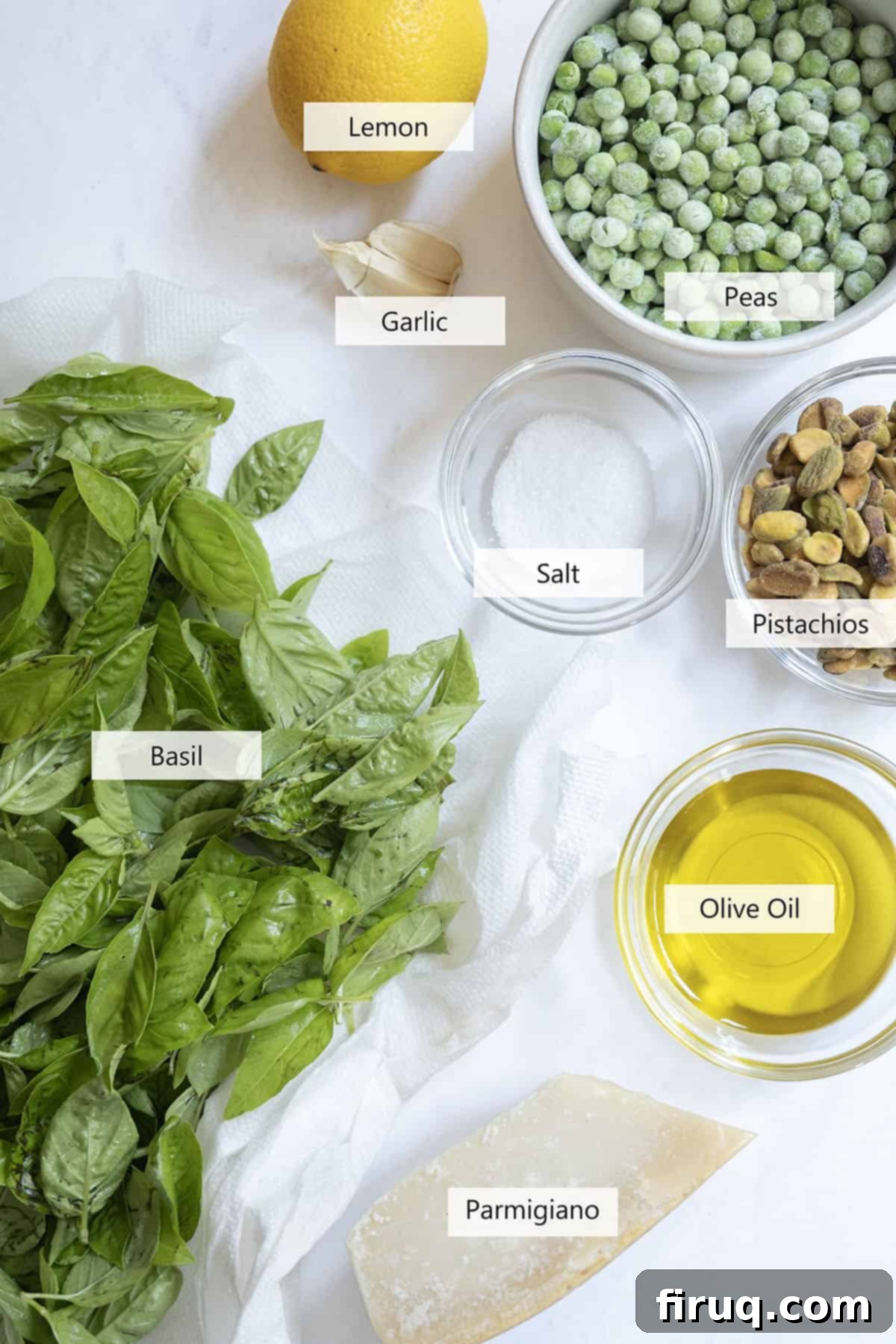
- Pistachios: We love the subtle sweetness and vibrant green color pistachios add to this pesto. For a more traditional flavor, you can certainly substitute pine nuts. Toasted cashews also work wonderfully, lending a creamier texture and a slightly different nutty profile. For those with a nut allergy, pumpkin seeds or sunflower seeds are excellent alternatives, providing a similar crunch and a healthy dose of nutrients. Just make sure to use raw, unsalted varieties if possible, and adjust salt to taste.
- Extra Virgin Olive Oil: This is the backbone of any good pesto, so quality matters! Always opt for a high-quality extra virgin olive oil. Its fresh, fruity notes are integral to the overall flavor profile. Avoid using old or rancid oil, as its off-notes will be very noticeable and detract from your delicious pesto. A good olive oil will provide a smooth, rich consistency and contribute significantly to the pesto’s depth of flavor.
- Parmigiano: For truly authentic taste, go with genuine Parmigiano Reggiano. You can identify it by its characteristic yellowish rind and the “Parmigiano Reggiano” stamp, indicating it’s made in Italy according to strict standards. Freshly grated Parmigiano offers a complex, nutty, and salty flavor that pre-grated varieties simply can’t match. It melts beautifully into the pesto, binding the ingredients and adding a crucial umami note.
- Basil: While peas are the star here, a small amount of fresh basil is essential for that signature pesto aroma and flavor. Use what you have, but remember the beauty of this recipe is its ability to deliver delicious pesto even when basil is scarce. If you have a little extra, feel free to add a bit more, but a single handful is all you truly need.
- Peas: Frozen peas are our secret weapon here! They are conveniently available year-round, affordable, and consistently sweet. There’s no need to blanch or cook them from scratch; simply microwave them until no longer frozen and let them cool. This quick prep ensures a smooth pesto texture and helps maintain a bright green color. If you happen to have fresh peas, you can use them, but be sure to blanch them first until tender-crisp, then cool them rapidly in an ice bath to preserve their color and sweetness.
- Garlic: Fresh garlic cloves are key for that pungent, aromatic kick. Adjust the amount to your preference – a little more if you love a garlicky punch, or a little less for a milder flavor.
- Lemon Juice & Salt: Freshly squeezed lemon juice brightens the flavors and helps prevent oxidation, keeping your pesto looking vibrant. Salt is essential for seasoning and bringing out the best in all the ingredients. Always season to taste.
*Please see the recipe card below for specific quantities and more detailed information on the ingredients.
How to Effortlessly Make Delicious Pea Pesto
Preparing this pea pesto is incredibly straightforward and quick! All you need is a reliable food processor and a few simple steps to transform these humble ingredients into a flavorful masterpiece.
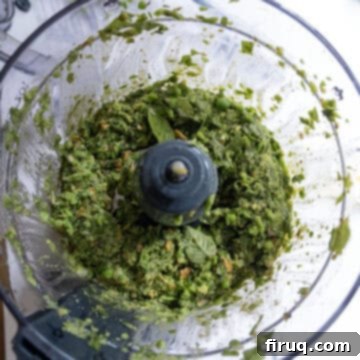
Step 1: Prep and Initial Blend. Begin by microwaving your frozen peas until they are just cooked through and no longer frozen. It’s important to let them cool completely afterwards. This prevents the pesto from turning dull brown and helps maintain a vibrant green color. Once cooled, combine the peas, fresh basil, garlic cloves, and raw pistachios in the bowl of your food processor. Pulse the mixture until the peas are completely broken down and the ingredients form a coarse, textured paste. Scrape down the sides of the bowl as needed to ensure everything is evenly processed.
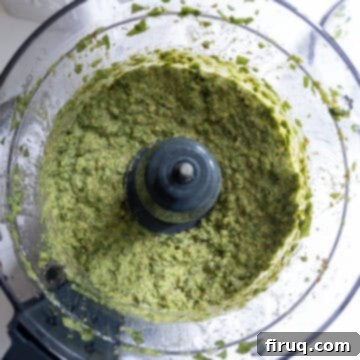
Step 2: Add Liquid Flavor and Emulsify. Now, add the fresh lemon juice and salt to the processor. With the food processor running, slowly drizzle in the extra virgin olive oil through the feed tube. This slow addition is crucial for emulsifying the oil into the other ingredients, creating a smooth, cohesive pesto. Continue processing until all the olive oil is incorporated and the mixture reaches a thick, creamy consistency. The lemon juice helps to brighten the overall flavor and preserves the vibrant green color of your pesto.
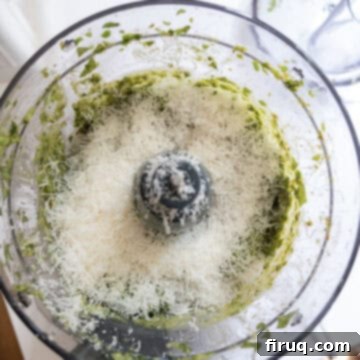
Step 3: Incorporate the Cheese. Finally, add the freshly grated Parmigiano cheese to the mixture. Pulse a few more times until the cheese is just incorporated. Avoid over-processing at this stage to prevent the cheese from becoming overly oily or gummy. The goal is to distribute it evenly while maintaining some texture.
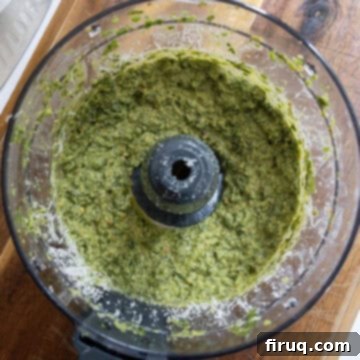
Step 4: Adjust Consistency and Seasoning. The consistency of your pesto is entirely up to your preference and how you plan to use it. If you prefer a looser, more spreadable pesto for pasta sauces or dressings, add a tablespoon or two more olive oil, processing until smooth. For a thicker, more paste-like pesto perfect for spreading on sandwiches or dolloping onto chicken, you might need less. Taste and adjust the seasoning as needed, adding more salt, lemon juice, or even a pinch of black pepper to achieve your desired flavor balance.
The beauty of homemade pesto lies in its customizability. Feel free to experiment with the amount of olive oil to achieve the perfect texture for your culinary needs. A slightly thinner pesto works wonders as a pasta sauce, while a thicker one is excellent for sandwiches or as a flavorful rub.
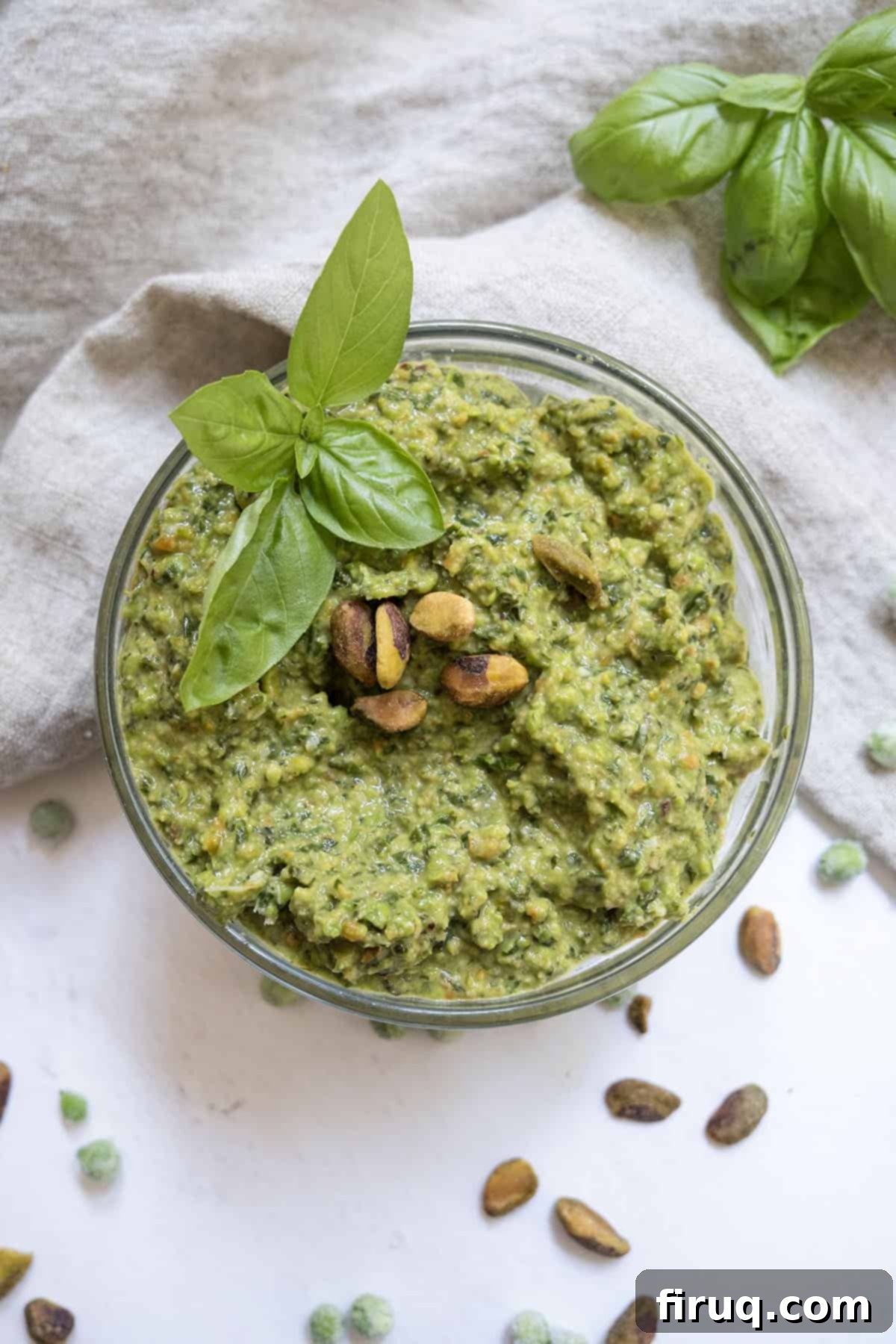
Pea Pesto Recipe FAQs
Proper storage is key to enjoying your pea pesto for as long as possible. Store freshly made pesto in an airtight container in the fridge for up to a week. To maintain its vibrant green color and prevent browning, you can pour a thin layer of olive oil over the surface before sealing the container. For longer storage, pea pesto freezes beautifully! Transfer it to an airtight bag, an ice cube tray, or a freezer-safe container, and it will keep for up to 6 months. Thaw in the fridge before use.
While peas are the main ingredient, their flavor is surprisingly subtle. The robust basil, pungent garlic, tangy lemon juice, nutty pistachios, and savory Parmigiano combine to create a balanced, complex flavor profile that largely overpowers the mild sweetness of the peas. Many people won’t even realize it’s pea-based, simply enjoying it as a delicious, fresh-tasting pesto!
Absolutely! If you have access to fresh peas, they will work wonderfully. Just be sure to blanch them in boiling salted water for 1-2 minutes until tender-crisp, then immediately transfer them to an ice bath to stop the cooking process and preserve their bright green color. Drain them thoroughly and allow them to cool completely before adding them to your food processor, just as you would with frozen peas.
Making this pesto nut-free is easy! Simply substitute the pistachios with an equal amount of raw pumpkin seeds (pepitas) or sunflower seeds. These seeds toast up beautifully and provide a similar texture and a lovely, earthy flavor, making it a safe and delicious option for those with nut allergies.
Creative Ways to Incorporate Pea Pesto into Your Meals
This pea pesto is a true kitchen hero, ready to add a burst of flavor to almost any dish. Its versatility makes it an indispensable condiment for quick weeknight meals or impressive entertaining. Here are some delicious ideas:
- With Seafood: The fresh, bright notes of pea pesto pair beautifully with various seafood. Drizzle it over perfectly cooked Fried Flounder Oreganata or use it as a flavorful garnish for Lemon Garlic Broiled Flounder. It can also be tossed with grilled shrimp or spooned over baked salmon for an easy and elegant meal.
- Elevate Your Pasta: Pesto and pasta are a match made in heaven! This pea pesto can transform any pasta dish. Swirl it into Simple Pasta with Eggplant and Tomatoes, or use it to enrich a Creamy Red Pepper Sauce. It’s also fantastic with heartier options like Farfalle with Sausage and Broccoli Rabe. For a unique twist, a dollop of pea pesto can even add a cheesy, herbaceous depth to a classic Sunday Sauce.
- Superior Sandwiches & Spreads: Take your sandwiches to the next level by spreading a generous amount of pea pesto. It’s fantastic on an Eggplant Parm Sandwich or an Italian Breakfast Sandwich, adding moisture and a powerful flavor punch. Use it as a vibrant spread for wraps, paninis, or even as a base for flatbreads.
- Vegetable Booster: Toss warm roasted vegetables like broccoli, asparagus, or potatoes with a spoonful of pea pesto for an instant flavor upgrade. It’s also delicious as a dressing for potato salad or green salads.
- Flavorful Dips: Mix it into hummus, Greek yogurt, or sour cream for a quick and easy dip for crudités, crackers, or pita bread.
I personally love adding pesto to red sauce. It introduces an incredible cheesy, herbaceous flavor that truly takes the sauce up a notch. The best part about having homemade pea pesto on hand, especially stored in the freezer, is that you never have to remember to make it on the same day you need it. It’s always there, ready to infuse your dishes with its wonderful taste!
More Pesto Creations to Explore
If you love the versatility and flavor of pesto, don’t stop here! There’s a whole world of pesto variations to discover. Here are some of our other favorite pesto recipes that offer unique flavor profiles and endless culinary possibilities:
- Busiate with Pesto Trapanese
- Pistachio Pesto
- Creamy Pesto Shrimp Pasta
- Lemon Pesto Spaghetti with Scallops
We hope you love this pea pesto recipe as much as we do! Don’t forget to save our website to your bookmarks for more delicious, easy-to-follow recipes. Follow us on Instagram @vindelgiudice or Tiktok @alwaysfromscratch to stay updated with our latest culinary adventures. If you try this recipe, please leave a review below! Your feedback goes a long way in helping us grow and reach more food lovers like you!
📖 Recipe
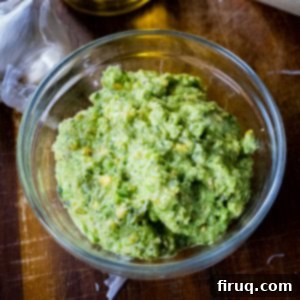
Pea Pesto
Vincent DelGiudice
Pin Recipe
Equipment
-
food processor
Ingredients
- ½ cup frozen peas, cooked and cooled
- ½ cup extra virgin olive oil
- 1 handful basil
- ¼ cup raw pistachios
- 2 cloves garlic
- ½ teaspoon salt
- 2 tablespoon lemon juice
- ¾ cup parmesan cheese
Instructions
-
In a food processor, combine the cooked and cooled peas, fresh basil, garlic, and pistachios. Process until the peas are completely broken down and the mixture forms a coarse paste. Add the lemon juice and salt. With the food processor running, slowly drizzle in the extra virgin olive oil until it is all incorporated and the pesto is smooth. Finally, add the freshly grated Parmesan cheese and pulse a few more times until just combined. Taste and adjust seasoning as needed, and add more olive oil if you prefer a looser consistency.
Notes
- This pea pesto recipe is perfect for making in large batches! It stores wonderfully in the freezer in an airtight bag or container for up to 6 months. Consider freezing it in ice cube trays for convenient single-serving portions.
- To keep your pesto a vibrant green, ensure the peas are thoroughly cooled before blending and consider adding a thin layer of olive oil on top when storing in the fridge.
Nutrition
Carbohydrates: 25g
Protein: 38g
Fat: 142g
Saturated Fat: 29g
Polyunsaturated Fat: 16g
Monounsaturated Fat: 92g
Cholesterol: 51mg
Sodium: 2372mg
Potassium: 623mg
Fiber: 8g
Sugar: 8g
Vitamin A: 1376IU
Vitamin C: 45mg
Calcium: 956mg
Iron: 4mg
